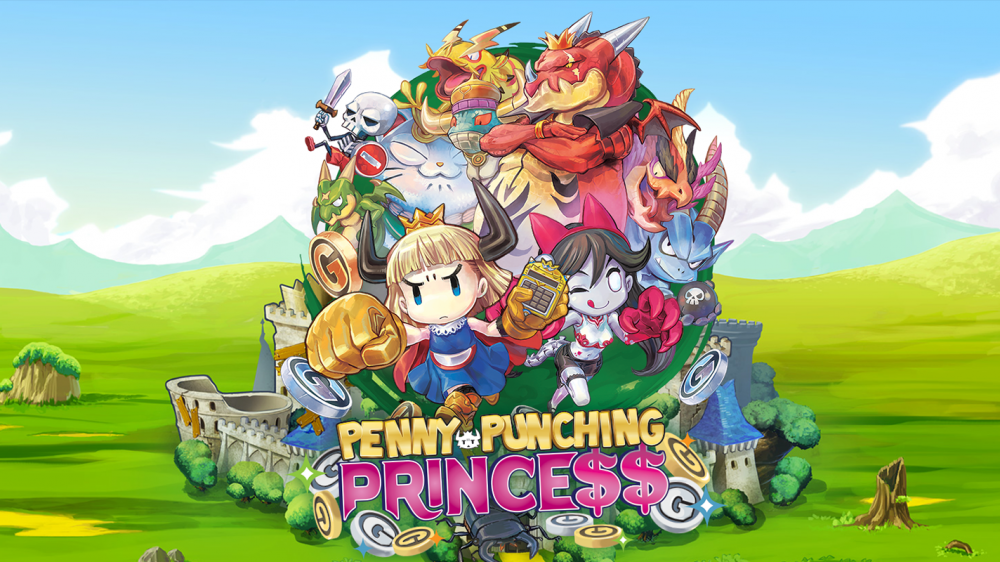
Short Version: It’s pretty good! It has creative ideas, along with charming characters, a good sense of humor and really fun mechanics that allow for different styles of play. It gets tough and unforgiving very quickly, but I never stopped having fun. If you want to invest in a game that will guarantee you many hours of play time, this would be a good choice.
Long Version: Dungeon crawling games, especially ones that opt for a more classic style, can easily suffer from feeling too similar to one another. On the other hand, there are also moments where dungeon crawlers employ gimmicks in order to stand out, but might not do enough to grab your attention for the whole thing. And then you have Penny-Punching Princess, a game that contains a good balance between exploring for loot and presenting novel ideas that are consistently fun to mess around with. Accompanied by some funny dialogue and some colorful art direction, Penny-Punching Princess got me hooked from the very beginning.
Bang For Your Buck
The game centers around a world that is entirely motivated by money. Anybody that has any form of power is due to their wealth, business skills and nothing else. This leads us to our protagonist, the Princess, who lost her father to overwhelming debt, stressing him to death. Out for revenge, the Princess travels to different islands with her butler Sebastian to defeat everyone that did them wrong and rise up from the financial ashes. It sounds pretty serious, but the game presents itself in every way but that. Everything is very colorful, light-hearted and full of humor, despite how the setup sounds on paper. Simply trying to describe your butler, who is literally a giant talking beetle with a bow tie, speaks a lot to the sheer ridiculousness of it all. There is also a lot of fun banter and money-related puns for you to delve into, which I always looked forward to after beating a level.
All of the characters are very charming in that no one truly feels like a good or bad guy; constantly trying their best to justify their horrible business decisions. They are simply people trying to get by through the rules of this world, rather than clearly delineating who’s objectively good or not. In fact, the game lets you know up front that most of the bad things that happened came from your father’s bad choices in his life, and this quest for revenge might not be the best way to solve these issues. Instead of making the story very simple and one-sided, it does challenge the characters and constantly point out their flaws in a really funny way that doesn’t come off as mean-spirited or cynical, which is a much welcome breath of fresh air these days.
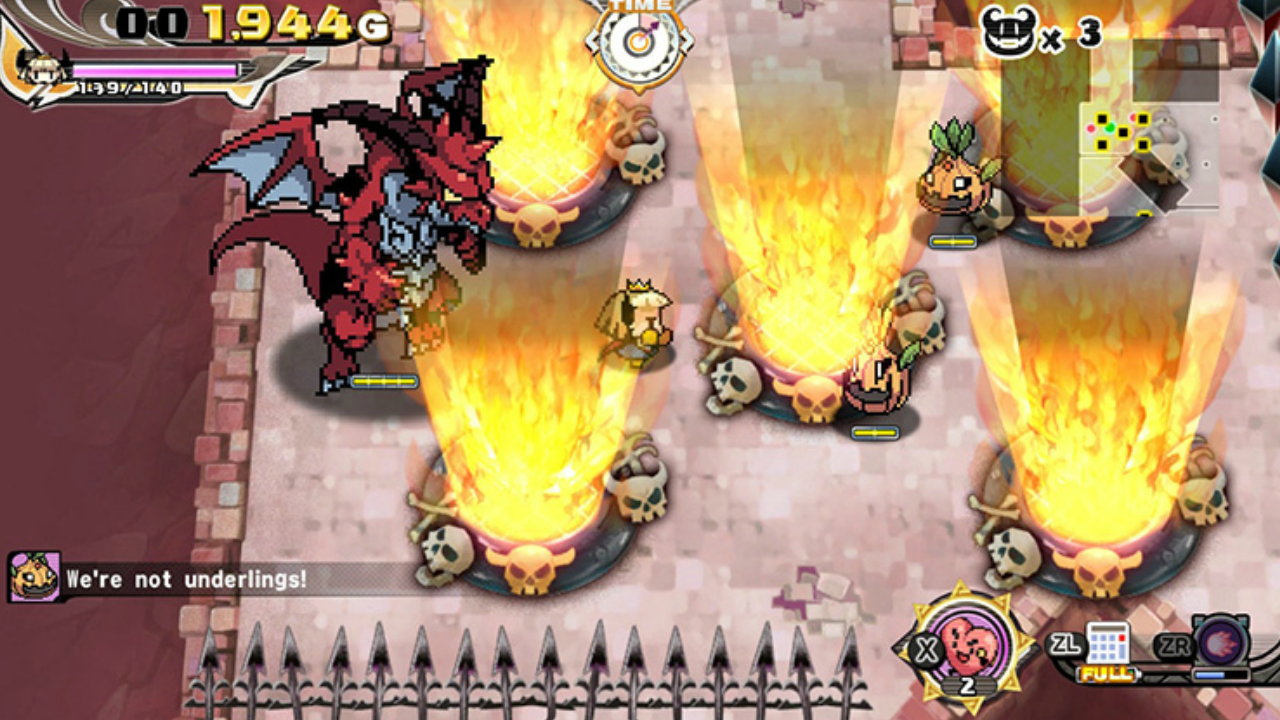
Money Makes the World Go ‘Round
Another breath of fresh air is the dungeon exploration itself, which introduces the heavy involvement of money in almost everything you do. This is manifested in the form of a magic calculator that you can use to bribe pretty much anything in a level. In this game, literally everyone has a price, and as long as you pick up enough coins, you can buy people off to end fights immediately, and then summon them to fight for you later. From monsters to even inanimate objects like traps and weapons, they can all be bribed to fight for you. Since all you can do on your own is throw relatively weak punches, being able to use the monsters to your advantage will be of great use.
The biggest amount of fun for me was always trying to bribe every single monster to see what attack I could get out of them. The summons have a very limited amount of uses, so the game always encourages you to try everything you find, including experimenting with different traps. There’s almost a Pokemon-esque excitement in exploring a new level that is full of new monsters to catch, which is what usually propelled me to keep going. It’s an ingenious idea that completely changes how to tackle a fight, leading to different strategies than the average game. You can’t win by just punching things a lot. You really do have to think on your toes and use everything at your disposal at any given moment to either obtain the most money or to survive.
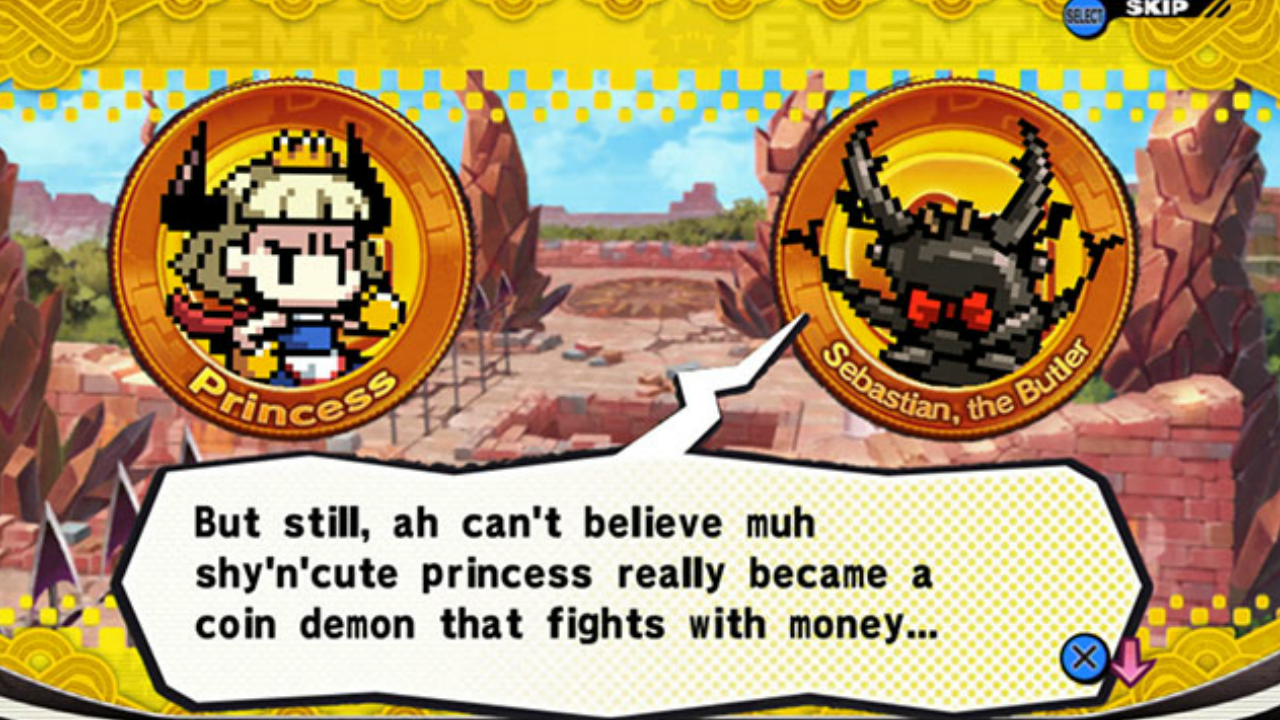
Take Out a Dragonloan
I played the Nintendo Switch version for this review, so I can only speak to my specific experience regarding the controls. My time with the Switch version was very positive, especially when there are significant differences between playing the game on the tablet than on TV. For starters, you can use touch controls on the tablet, which allows you to punch in all the numbers into your calculator, and then simply tapping on the enemy you want to bribe. In addition, you can also rapidly tap on stunned enemies to get more coins. This all sounds fun on paper until you actually try pulling it off.
I got pretty mixed results in the touch controls feeling fun and natural on the first few levels. However, that wasn’t the case with more difficult levels later on, where you are constantly on the move and don’t have time to take your hands out of the buttons to tap on stuff on the screen. Also, the Switch’s screen is pretty wide, so there will be many times where the enemies won’t be easy to reach by just stretching out your thumb a little bit. You will have to stop what you’re doing, cut your controls in half by lifting one of your hands and taking the time reach out to the one enemy you want to tap. By the time you decide to do any of that, you either got killed by everything else chasing you or your time ran out and the enemy got up again.
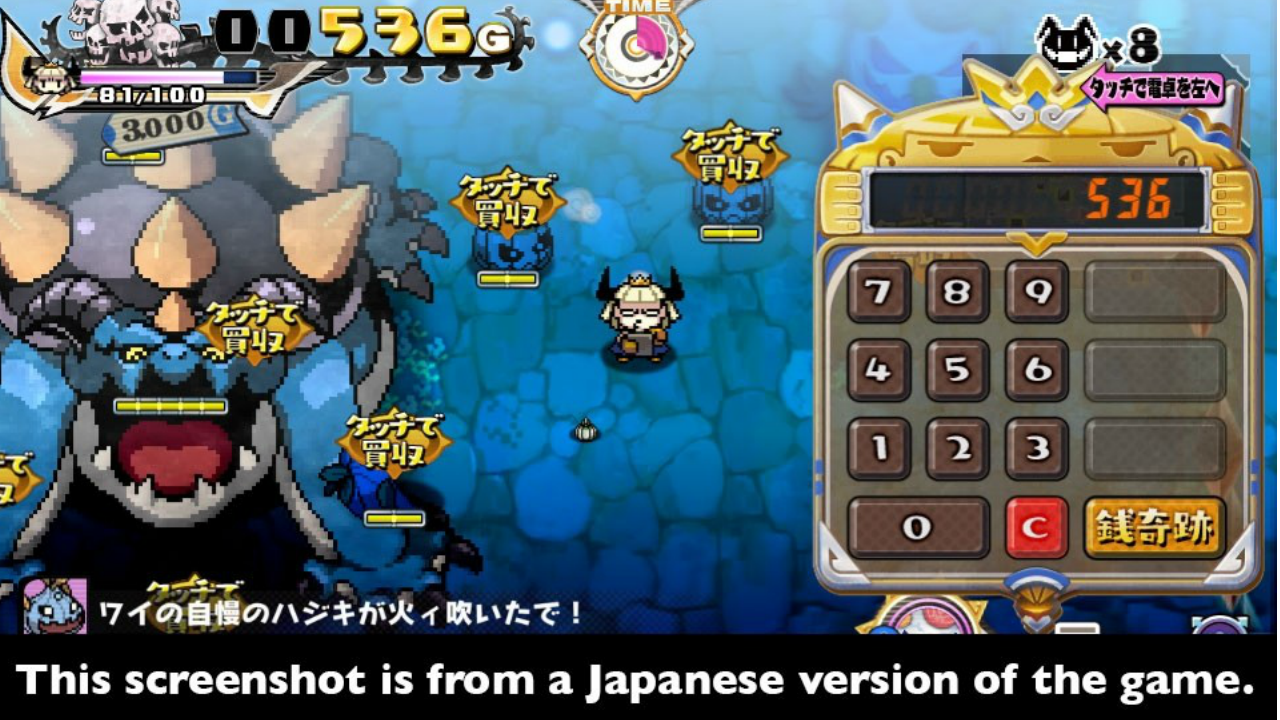
Good Ol’ Cold, Hard Cash
This pales in comparison to the regular button controls, which are much more efficient than touch controls. The biggest amount of comfort I had was in keeping my Switch docked to the TV and playing with a Pro Controller. Just a couple taps of the shoulder buttons and you have your calculator on screen with an enemy automatically locked in, ready to be bribed. This is much faster than having to punch in all the numbers, then tap who you want to bribe. This is especially true in more difficult and crowded levels where you have to make lightning-fast decisions. Another big difference between the two control schemes is how you get money out of enemies.
After stunning them, you can either tap on them to make coins come out, or you can spin the right stick with regular controls. Tapping barely gives you anything, and by the time you decide to reach out with your hands, as mentioned before, you will likely miss your chance. However, it is much better to rotate the stick, since that part of the controller is much closer and faster to get to, filling almost the entire screen with coins in just a couple seconds. I wish I could say that the controls depend on you preference, but I can’t. There is a very clear winner here if you want to succeed in this game, with one being much more efficient than the other.

Money in the Bank
If there are any other criticisms I can give, it would boil down to two more things: The sound effects and the difficulty curve. The former is a slight pet-peeve that might not bother anyone else other than myself, but I thought the sound design to be pretty lackluster. I want to be very specific about the sounds and not the soundtrack, which I found to just get better every time I visited a new set of levels. I want to be specific in how I think a lot of the sound effects didn’t reflect the same level of quality as the rest of the game. Most of it sounded like what you would get as free samples in some sort of music creation software. It doesn’t bother me too much, but I think it’s worth pointing out how it would sometimes take me out of the experience when I paid attention to it.
One last thing I want to point out is how quickly the game’s difficulty rises. In Chapter 1, everything goes smoothly and found some reasonable progression. But for some reason, I reached Chapter 2 and had a really tough time just getting through one level. I would find myself constantly dying to an excess of enemies and traps, all of which were targeting me with no mercy. Even bribing doesn’t do much sometimes, since you have to wait for a meter to fill up every time you use your calculator. You end up having to either risk getting killed by punching enemies, or somersault out of there until you can bribe again. I know you can upgrade your character as you keep obtaining skill points and items, but it is very difficult to tell the difference unless to take up a lot of time grinding in previous levels and boosting yourself much more than I feel it necessary.
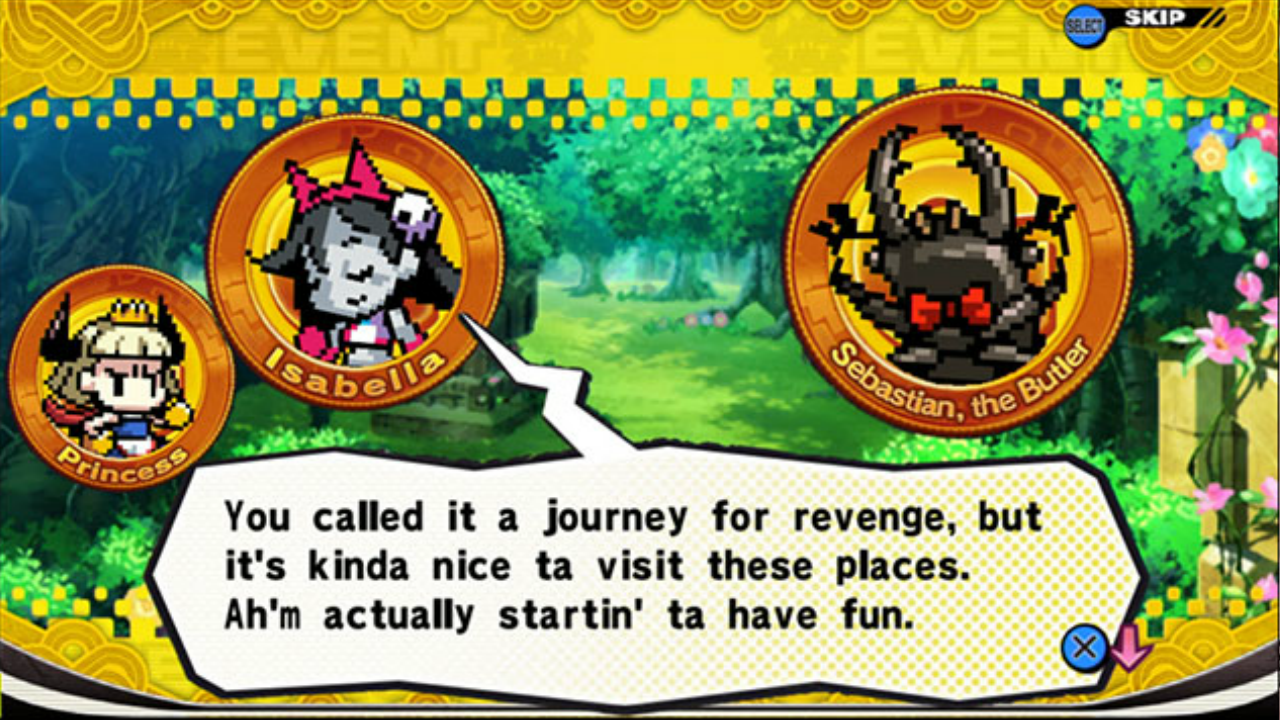
A Good Investment
On the opposite end of the spectrum, some battles can be way too easy and anticlimactic due to the bribing system itself. Everything short of the bosses can be bought out and used for combat, so there were many moments where I got stuck trying to beat a tough enemy, but then thought, “Oh right, I can just buy them.” After that, I bribed the enemy and it was over, which made me feel like all of my previous efforts in trying to beat that enemy was a waste of time. Of course, getting all the bigger enemies to your side makes the bosses much easier too. During my whole experience, I found myself in this strange feeling of imbalance, combat-wise. The battles were either way too easy due to buying the tougher guys, or it would be an overwhelming mob of enemies to the point of losing track of where you are and dying in a frustrating, almost unfair way. I really wish there was a better balance in easing me in to harder fights, rather than throwing me to the capitalist lions as soon as the tutorials were done.
Overall, despite my complaints, I still had a lot of fun with Penny-Punching Princess. I love the creative ideas this game has and how it makes it fun to get through multiple times. Even with the difficulty curve, underwhelming sound effects and finicky touch controls, this game still has a lot to provide and will charm you into seeing it through to the end. The game’s writing, along with its attractive art style, solid soundtrack and really fun combat make up for these faults. If you are looking to fill up your Switch library, or at least looking to spend your money on something that will guarantee a large amount of hours in play time, then I say this is a solid title to go for.
Special thanks to NIS America for providing a Nintendo Switch review code. Thank you very much!










Game Review – Penny-Punching Princess (Nintendo Switch)
0Short Version: It’s pretty good! It has creative ideas, along with charming characters, a good sense of humor and really fun mechanics that allow for different styles of play. It gets tough and unforgiving very quickly, but I never stopped having fun. If you want to invest in a game that will guarantee you many hours of play time, this would be a good choice.
Long Version: Dungeon crawling games, especially ones that opt for a more classic style, can easily suffer from feeling too similar to one another. On the other hand, there are also moments where dungeon crawlers employ gimmicks in order to stand out, but might not do enough to grab your attention for the whole thing. And then you have Penny-Punching Princess, a game that contains a good balance between exploring for loot and presenting novel ideas that are consistently fun to mess around with. Accompanied by some funny dialogue and some colorful art direction, Penny-Punching Princess got me hooked from the very beginning.
Bang For Your Buck
The game centers around a world that is entirely motivated by money. Anybody that has any form of power is due to their wealth, business skills and nothing else. This leads us to our protagonist, the Princess, who lost her father to overwhelming debt, stressing him to death. Out for revenge, the Princess travels to different islands with her butler Sebastian to defeat everyone that did them wrong and rise up from the financial ashes. It sounds pretty serious, but the game presents itself in every way but that. Everything is very colorful, light-hearted and full of humor, despite how the setup sounds on paper. Simply trying to describe your butler, who is literally a giant talking beetle with a bow tie, speaks a lot to the sheer ridiculousness of it all. There is also a lot of fun banter and money-related puns for you to delve into, which I always looked forward to after beating a level.
All of the characters are very charming in that no one truly feels like a good or bad guy; constantly trying their best to justify their horrible business decisions. They are simply people trying to get by through the rules of this world, rather than clearly delineating who’s objectively good or not. In fact, the game lets you know up front that most of the bad things that happened came from your father’s bad choices in his life, and this quest for revenge might not be the best way to solve these issues. Instead of making the story very simple and one-sided, it does challenge the characters and constantly point out their flaws in a really funny way that doesn’t come off as mean-spirited or cynical, which is a much welcome breath of fresh air these days.
Money Makes the World Go ‘Round
Another breath of fresh air is the dungeon exploration itself, which introduces the heavy involvement of money in almost everything you do. This is manifested in the form of a magic calculator that you can use to bribe pretty much anything in a level. In this game, literally everyone has a price, and as long as you pick up enough coins, you can buy people off to end fights immediately, and then summon them to fight for you later. From monsters to even inanimate objects like traps and weapons, they can all be bribed to fight for you. Since all you can do on your own is throw relatively weak punches, being able to use the monsters to your advantage will be of great use.
The biggest amount of fun for me was always trying to bribe every single monster to see what attack I could get out of them. The summons have a very limited amount of uses, so the game always encourages you to try everything you find, including experimenting with different traps. There’s almost a Pokemon-esque excitement in exploring a new level that is full of new monsters to catch, which is what usually propelled me to keep going. It’s an ingenious idea that completely changes how to tackle a fight, leading to different strategies than the average game. You can’t win by just punching things a lot. You really do have to think on your toes and use everything at your disposal at any given moment to either obtain the most money or to survive.
Take Out a Dragonloan
I played the Nintendo Switch version for this review, so I can only speak to my specific experience regarding the controls. My time with the Switch version was very positive, especially when there are significant differences between playing the game on the tablet than on TV. For starters, you can use touch controls on the tablet, which allows you to punch in all the numbers into your calculator, and then simply tapping on the enemy you want to bribe. In addition, you can also rapidly tap on stunned enemies to get more coins. This all sounds fun on paper until you actually try pulling it off.
I got pretty mixed results in the touch controls feeling fun and natural on the first few levels. However, that wasn’t the case with more difficult levels later on, where you are constantly on the move and don’t have time to take your hands out of the buttons to tap on stuff on the screen. Also, the Switch’s screen is pretty wide, so there will be many times where the enemies won’t be easy to reach by just stretching out your thumb a little bit. You will have to stop what you’re doing, cut your controls in half by lifting one of your hands and taking the time reach out to the one enemy you want to tap. By the time you decide to do any of that, you either got killed by everything else chasing you or your time ran out and the enemy got up again.
Good Ol’ Cold, Hard Cash
This pales in comparison to the regular button controls, which are much more efficient than touch controls. The biggest amount of comfort I had was in keeping my Switch docked to the TV and playing with a Pro Controller. Just a couple taps of the shoulder buttons and you have your calculator on screen with an enemy automatically locked in, ready to be bribed. This is much faster than having to punch in all the numbers, then tap who you want to bribe. This is especially true in more difficult and crowded levels where you have to make lightning-fast decisions. Another big difference between the two control schemes is how you get money out of enemies.
After stunning them, you can either tap on them to make coins come out, or you can spin the right stick with regular controls. Tapping barely gives you anything, and by the time you decide to reach out with your hands, as mentioned before, you will likely miss your chance. However, it is much better to rotate the stick, since that part of the controller is much closer and faster to get to, filling almost the entire screen with coins in just a couple seconds. I wish I could say that the controls depend on you preference, but I can’t. There is a very clear winner here if you want to succeed in this game, with one being much more efficient than the other.
Money in the Bank
If there are any other criticisms I can give, it would boil down to two more things: The sound effects and the difficulty curve. The former is a slight pet-peeve that might not bother anyone else other than myself, but I thought the sound design to be pretty lackluster. I want to be very specific about the sounds and not the soundtrack, which I found to just get better every time I visited a new set of levels. I want to be specific in how I think a lot of the sound effects didn’t reflect the same level of quality as the rest of the game. Most of it sounded like what you would get as free samples in some sort of music creation software. It doesn’t bother me too much, but I think it’s worth pointing out how it would sometimes take me out of the experience when I paid attention to it.
One last thing I want to point out is how quickly the game’s difficulty rises. In Chapter 1, everything goes smoothly and found some reasonable progression. But for some reason, I reached Chapter 2 and had a really tough time just getting through one level. I would find myself constantly dying to an excess of enemies and traps, all of which were targeting me with no mercy. Even bribing doesn’t do much sometimes, since you have to wait for a meter to fill up every time you use your calculator. You end up having to either risk getting killed by punching enemies, or somersault out of there until you can bribe again. I know you can upgrade your character as you keep obtaining skill points and items, but it is very difficult to tell the difference unless to take up a lot of time grinding in previous levels and boosting yourself much more than I feel it necessary.
A Good Investment
On the opposite end of the spectrum, some battles can be way too easy and anticlimactic due to the bribing system itself. Everything short of the bosses can be bought out and used for combat, so there were many moments where I got stuck trying to beat a tough enemy, but then thought, “Oh right, I can just buy them.” After that, I bribed the enemy and it was over, which made me feel like all of my previous efforts in trying to beat that enemy was a waste of time. Of course, getting all the bigger enemies to your side makes the bosses much easier too. During my whole experience, I found myself in this strange feeling of imbalance, combat-wise. The battles were either way too easy due to buying the tougher guys, or it would be an overwhelming mob of enemies to the point of losing track of where you are and dying in a frustrating, almost unfair way. I really wish there was a better balance in easing me in to harder fights, rather than throwing me to the capitalist lions as soon as the tutorials were done.
Overall, despite my complaints, I still had a lot of fun with Penny-Punching Princess. I love the creative ideas this game has and how it makes it fun to get through multiple times. Even with the difficulty curve, underwhelming sound effects and finicky touch controls, this game still has a lot to provide and will charm you into seeing it through to the end. The game’s writing, along with its attractive art style, solid soundtrack and really fun combat make up for these faults. If you are looking to fill up your Switch library, or at least looking to spend your money on something that will guarantee a large amount of hours in play time, then I say this is a solid title to go for.
Special thanks to NIS America for providing a Nintendo Switch review code. Thank you very much!
Naruto Shippuden: Ultimate Ninja Storm Trilogy Coming to Nintendo Switch
Game Review – Reverie